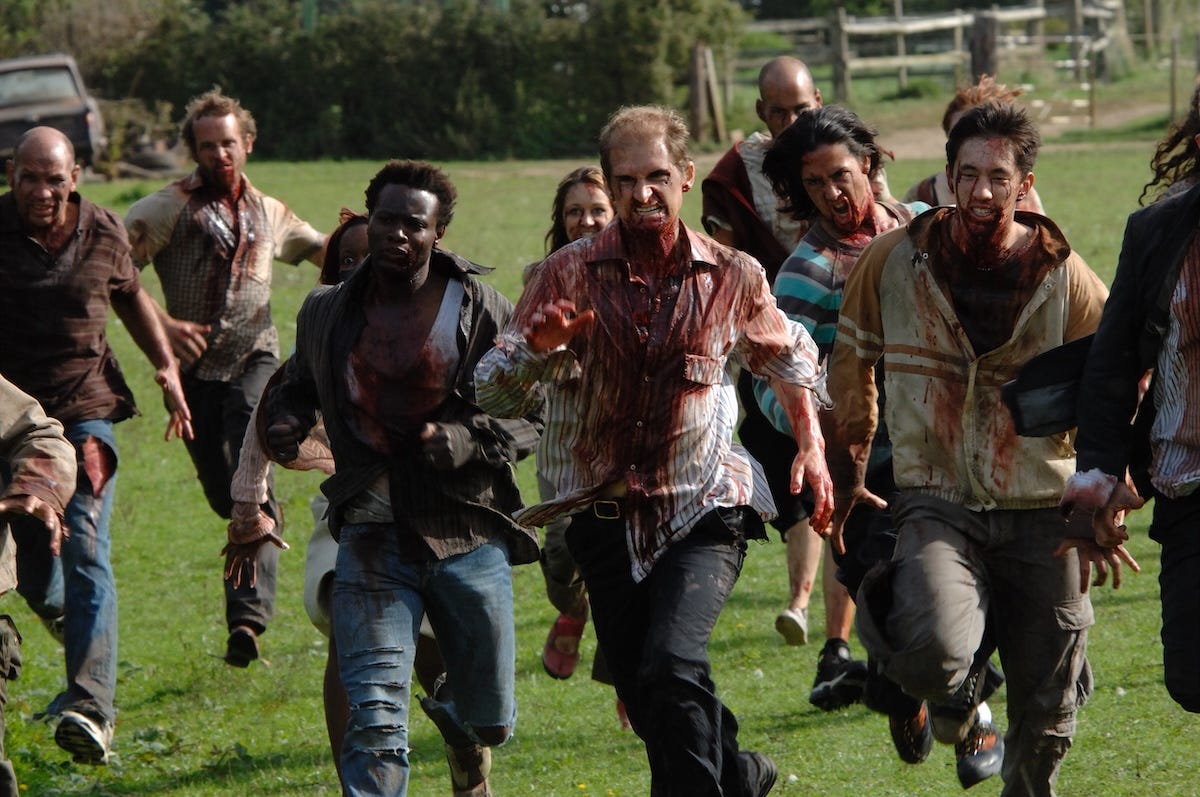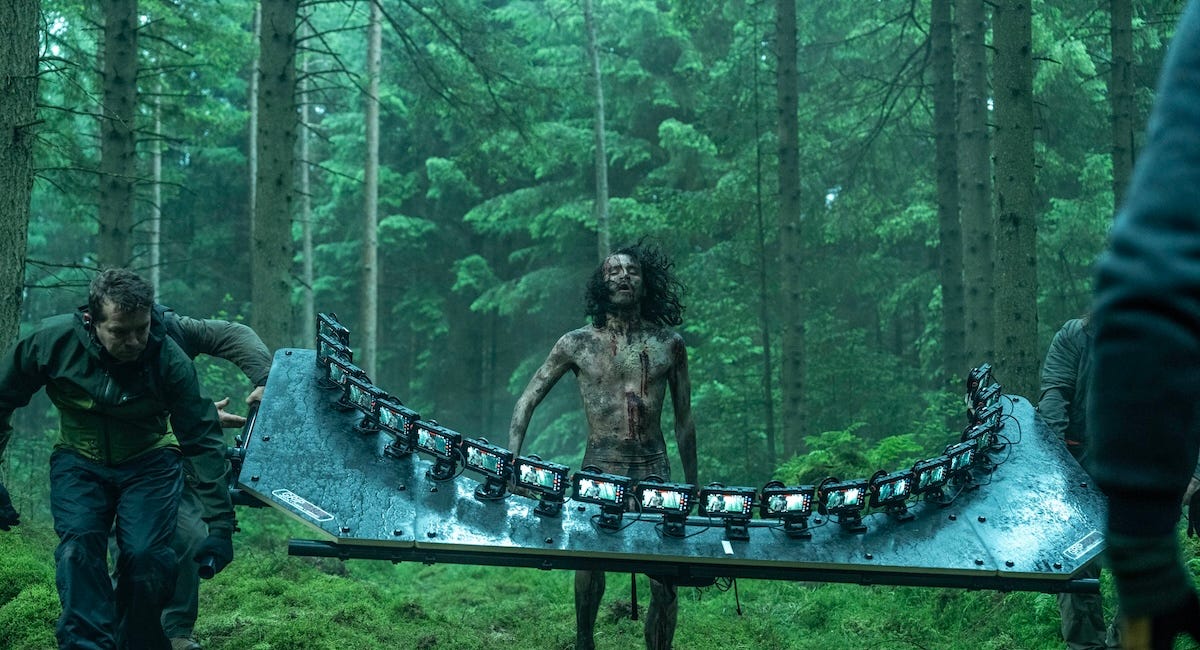When I mentioned I was reviewing 28 Years Later, Bulwark Managing Editor Sam Stein asked for clarity on a subject: which zombie stories work and why. The subject arose due to the ratings decline for season two of The Last of Us, HBO’s hit adaptation of the video game about a fungal zombie apocalypse.
For what it’s worth, I enjoyed the second season fine, though less than the first. Part of that has to do with the departure of a major cast member in the show’s second episode; when you lose one of your leads and the other lead doesn’t quite have the charisma to carry the program, it’s a problem. The bigger issue, though, was one that struck me as pretty obvious and fairly simple: There weren’t enough zombies. This was also a critique of the first season, but the problem felt exacerbated this year: There was one massive zombie assault in the early going (and another similar wave in a mid-season episode), but for the most part, the tension was all human-on-human.
And, yes, before you yell at me, I know that the foundational thematic principle of virtually all zombie media—from George Romero’s Night of the Living Dead and its sequels to 28 Days Later to The Walking Dead—is that “man is the real monster.” This is why Daniel Drezner’s 2015 book, Theories of International Politics and Zombies, is so amusing and such a weirdly useful analytical tool for international relations students. As Drezner put it, “Whether researchers or policy makers admit it or not, all coherent international relations work proceeds from some paradigmatic assumptions. A theoretical attack of the undead can further reveal how these different approaches diverge in their predictions.”
But still: you need the monsters to create the chaos that allows us to explore those theories! This is, in our heart of hearts, what we truly enjoy about zombie media. We revel in the design of the Clickers on The Last of Us, the saprophytic protrusions exploding from the heads of those who have breathed in the fungal spores. (Indeed, one of the most haunting images from the new season involves infected people trapped in wall-supported cocoons and kept “alive” so their lungs can serve as spore factories.) The only reason The Return of the Living Dead, a bad movie, persists is the brilliant design of the punk zombies, a genius fusing of leather and decay.
The rise of the fast zombies from 28 Days Later (2002) was controversial in fandom at least in part because it changed the dynamics of the aesthetic: zombies had, to that point, been slow, shuffling masses, often serving as a metaphor for mindless consumption and conformity, particularly in George Romero’s classic Dawn of the Dead. Remaking that movie with fast zombies, as Zack Snyder did in 2004, was tantamount to heresy. Frankly, I prefer the fast variety, in no small part because I simply do not buy that a society as well armed as the United States would have much trouble quelling the initial slow zombie outbreaks; your willing suspension of disbelief may vary.
And the 28 Days Later variety of undead also cemented something more concrete about zombie outbreaks: Zombieism as a transmissible disease. Whether the zombies technically died first or not was less important than how they behaved. So bites transform people, sure, but because of blood and saliva—the first person-to-person transmission in that film happens when one person infected with the Rage Virus vomits blood into the face of another; in 28 Weeks Later, Britain’s doom is sealed with a kiss—not, you know, Zombie magic or whatever. And then there are airborne particles, as in The Last of Us. Disease means infection, but it also provides a concrete way to avoid it. The boom in zombie literature predates Covid, of course, but it’s no wonder that the idea of contagion and safety-through-isolation (remember your “pod”?) strikes such a powerful chord with those of us who lived through that whole mess.
Again, this all serves to make the zombie threat more relatable and thus help us understand our own social problems better. I guess what doesn’t really work about The Last of Us’s new season is that the zombies are, frankly, tertiary to the action. The season’s central conflict—between a group of survivors in Seattle and Ellie and Joel in Wyoming—is self-consciously about “the cycle of violence,” how eye for an eye leaves everyone blind, and other self-congratulatory platitudes that inspire eye rolls more than shudders of fear.
And waves of fear—from the Deadites to the Munchers to the Rage Alphas (you’ll meet them this weekend)—are what most of us really want in a zombie movie.
THIS WEEK ON THE SHOW:
You Can Make a Movie with Your Phone
On this week’s episode, I’m rejoined by Bart Weiss to discuss the evolution of the iPhone-shot movie from Tangerine to 28 Years Later and his recent book, Smartphone Cinema: Making Great Films with Your Mobile Phone. You have the power to make a movie in the palm of your hand: will you use it?
Follow Bulwark Goes To Hollywood to your player of choice:
Apple Podcasts | Spotify | Amazon Music | Bulwark+ and More
28 Years Later Review
[This] is a profoundly British movie. The residents of Holy Island have, as an enclave, attempted to maintain as much of Old Britannia as possible, including portraits of a long-dead monarch who ruled in a now-ruined city. It’s a movie that is obsessed with the idea of what it means to conceive of oneself as British, how British myths and the British past inform the British present, how the cinematic imagery of Britain—of archers on battlements firing at onrushing hordes; of boys readying themselves to head to the trenches of World War I; images of valor, or maybe “valor”—still defines the idea of “Britain.” It’s no coincidence that Rudyard Kipling’s poem about the Second Boer War, “Boots,” is a recurring motif; a haunting recording of the poem is used both in psychological warfare training by the U.S. military and in the trailer for 28 Years Later, helping it to win a Golden Trailer award.
Boyle, never one to shy away from tricky editing maneuvers, splices in fragments from other films to demonstrate this internal idealization of Britishness, the cuts suggesting a sort of fragmented-but-unified view of the world, of Britain as the last holdout against the barbarian hordes. That point-of-view trickery extends to the filming of the action sequences; Boyle used an array of iPhones filming simultaneously to create the impression of a sort of bullet time that shows impacts from several points of view at once. It’s a neat effect, one that allows the director and his editor, Jon Harris, to maintain the kinetic force of the film without losing clarity on any individual moment.
To read the full review, click here.
If You’re in the Mood for Love instead of Zombies
Does 'Materialists' Work?
In this episode of Across the Movie Aisle, host Sonny Bunch is joined by Alyssa Rosenberg and Peter Suderman to unpack the outrage over indie film platform MUBI’s investment ties and whether ethical boycotts are even coherent in modern capitalism. Then they dig into Celine Song’s latest film
Follow Across The Movie Aisle to your player of choice:
Apple Podcasts | Spotify | Amazon Music | Bulwark+ and More
In this bonus episode of Across the Movie Aisle, we debate the state of the romantic comedy. Is When Harry Met Sally the unbeatable blueprint for the entire genre? Why have rom-coms fallen off—and are they finally making a comeback?
Assigned Viewing: The Seed of the Sacred Fig (Hulu)
Iranian filmmaker Mohammad Rasoulof was sentenced to jail for eight years (as well as flogging and heavy fines) by the regime ahead of the release of this film, which premiered at Cannes last year. It’s a bit long, at 168 minutes, but gripping throughout; it’s a shocking indictment of life under authoritarian theocracy with a ground-eye view inside the brutal bureaucracy. Rasoulof exposes the cruelty inherent to any such system not only by highlighting the injustice of having individuals sign off on death sentences as little more than administrative paperwork, but also through his intimate portrayal of the way the strain of such evil degrades both his soul and his relationship with his wife and daughters. (The two movies Sacred Fig called to mind for me were The Lives of Others and, oddly, Stanley Kubrick’s The Shining.)
The Seed of the Sacred Fig earned an Oscar nomination for best foreign language feature for Germany, to which Rasoulof fled after his conviction, and writer-director Whit Stillman reminds us that now might be the perfect time to revisit this film given, you know, everything going on right now. It’s streaming on Hulu. I hope you give it a gander.








I always look forward to Sonny’s assigned viewing, and the seed of the sacred fig was both great and super relevant obviously. Took a couple sessions to get through between parenting and work commitments, but well worth the running time.
I think your review of 28 Years was spot on: It felt like three different movies. I would say the last one, especially the last scene, was my least favorite by far. It felt like that tonal shift cheapened the entire movie.